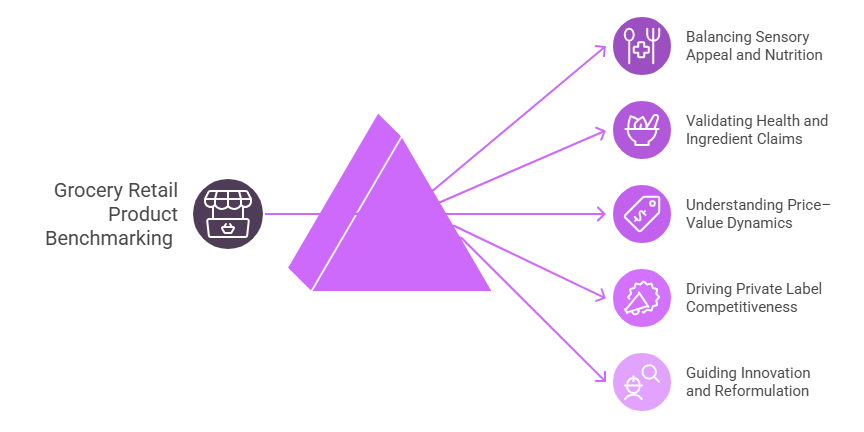The modern grocery retail landscape is undergoing a major shift as consumers increasingly seek products that balance taste, health, and value. Shoppers are more conscious than ever about nutrition, ingredients, and sustainability but they are equally unwilling to compromise on flavor and indulgence. For grocery retailers and food manufacturers, this creates a complex challenge: how to innovate for wellness without losing sensory appeal.
Amid this transformation, many brands are expanding their product portfolios with “better-for-you” variants, functional foods, and fortified alternatives. However, not all new products achieve the desired traction. The key differentiator often lies in how well each product performs against competitors in terms of taste quality, nutritional composition, and perceived value.
This is where Product Benchmarking Intelligence becomes critical. By comparing SKU-level performance across sensory, nutritional, and pricing parameters, grocery retailers can pinpoint what drives consumer preference and repeat purchase behavior.
Why Benchmarking Matters in Grocery Retail
In grocery retail, success is increasingly defined by a brand’s ability to meet evolving consumer expectations, delivering products that are both enjoyable and aligned with healthier lifestyles. Product benchmarking helps retailers and food manufacturers decode what makes certain products stand out on the shelf, combining sensory performance, nutritional value, and consumer perception into measurable intelligence.

- Balancing Sensory Appeal and Nutrition: Consumers want healthier options without compromising taste. Benchmarking helps evaluate competing SKUs on parameters like flavor intensity, aroma, texture, and aftertaste, while also analyzing sugar, sodium, and fat content. This dual perspective enables brands to identify where they can improve taste while maintaining nutritional integrity.
- Validating Health and Ingredient Claims: With claims like “organic,” “low-sodium,” or “high-protein” flooding the market, benchmarking validates whether such claims align with actual composition and consumer perception. This ensures authenticity, regulatory compliance, and stronger brand trust.
- Understanding Price–Value Dynamics: Benchmarking allows retailers to study how price influences perceived value across both premium and value segments. It helps determine the right pricing strategy for health-focused or indulgent products to maximize affordability without eroding margins.
- Driving Private Label Competitiveness: Retailer-owned brands are competing head-to-head with national players. Benchmarking taste and nutritional performance across categories empowers private labels to match or exceed branded products in quality and consumer satisfaction.
- Guiding Innovation and Reformulation: Insights from benchmarking highlight gaps in flavor, health positioning, and ingredient innovation. These insights guide R&D teams in reformulating products that deliver on both health goals and sensory delight.
In essence, product benchmarking provides grocery retailers a data-backed blueprint to design assortments that are not just competitive, but also healthier and more consumer-relevant.
Nexdigm’s Grocery Product Benchmarking Intelligence Framework
Nexdigm’s Grocery Product Benchmarking Intelligence Framework enables food manufacturers and retailers to build product portfolios that deliver both superior taste and measurable health outcomes. The framework integrates sensory analytics, nutritional assessment, and market intelligence to help decision-makers create product lines that resonate with evolving consumer priorities.
- SKU-Level Sensory and Nutritional Benchmarking: Nexdigm benchmarks product formulations across categories such as snacks, ready meals, beverages, and bakery items. It evaluates flavor intensity, aroma, mouthfeel, and overall taste experience alongside nutritional parameters like calorie density, sodium levels, and protein content, identifying where each SKU stands in the balance between indulgence and wellness.
- Consumer Preference Correlation: Our framework connects sensory results with consumer preference and purchase data. By understanding how flavor and health perceptions shape buying behavior, brands can adjust product attributes to improve both satisfaction and repeat purchase intent.
- Price and Value Mapping: Through competitive benchmarking of price points and pack sizes, Nexdigm helps brands evaluate price-to-nutrition alignment, determining how much consumers are willing to pay for health-focused or functional products without compromising taste.
- Category-Level Competitiveness Index: Nexdigm develops a Competitiveness Index that combines sensory scores, nutritional metrics, and value perception to rank SKUs within each category. This index identifies high-performing and underperforming products, guiding reformulation and marketing priorities.
- Strategic Insights and Implementation Roadmap: All insights are consolidated into a tailored Product Benchmarking Dashboard, offering clear recommendations on reformulation, SKU optimization, and positioning. This ensures that every product decision supports brand health, market competitiveness, and consumer well-being.
Nexdigm’s Product Benchmarking Intelligence empowers food and beverage companies to find that balance. By integrating sensory analytics, nutritional assessment, and market comparison, we help retailers and manufacturers create healthier, tastier, and more competitive product portfolios.
To take the next step, simply visit our Request a Consultation page and share your requirements with us.
Harsh Mittal
+91-8422857704

